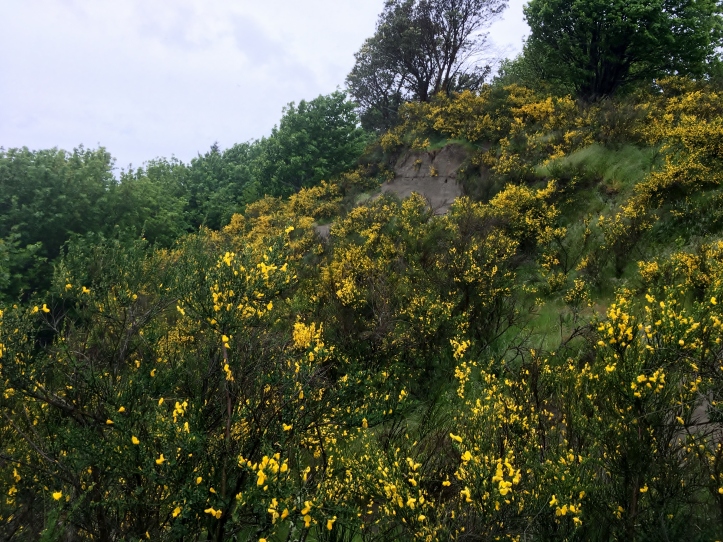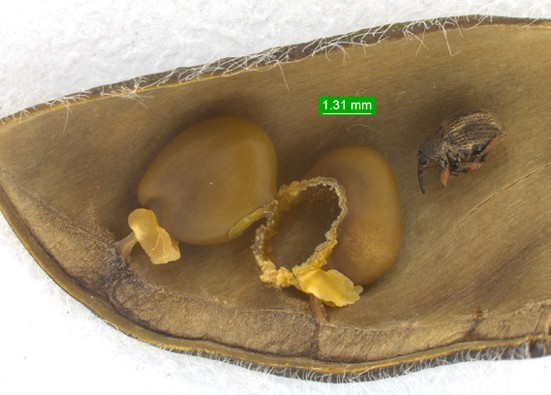
On a cold and rainy May morning, I walk with Weed Specialist Karen Peterson along the bluffs at the west edge of Seattle’s Discovery Park. As usual, we’re here to control weeds—in this case, a large stand of Scotch broom (Cytisus scoparius)—but we’re not doing it in the usual way. I’m holding what looks like a pint of ice cream with a sticker where its flavor should be. “Release on: SCOTCH BROOM,” the sticker reads. And on the next line: “KEEP INSECTS COOL.” When we reach a sandy trail that switchbacks down the slope, Peterson stops and pulls out a soggy map. “This is it,” she says, and clambers down.

The Scotch broom bruchid (Bruchidius villosus) is a 2-mm-long dark gray beetle that looks, to many of us, almost impressively unassuming. It’s also one of two common biological control agents for Scotch broom in King County. The other is the equally inconspicuous Scotch broom seed weevil (Exapion fuscirostre).

Every spring, Scotch broom bruchid females lay their eggs on their namesake plants’ seed pods. One to two weeks later, each newly hatched larvae digs its way into a seed, where it eats and pupates, emerging when the seed pod opens in July or August. Scotch broom seed weevil has a life cycle similar to that of the Scotch broom bruchid, but eats the seeds’ outer rims.

By destroying Scotch broom seeds, the two beetles inhibit the noxious weed’s spread—sometimes by huge amounts. For instance, in North Carolina the bruchid often destroys more than 80% of Scotch broom seeds. In our area, the success rate is as high as 95%, though it varies significantly across sites.



About a week after my field trip with Karen, I travel with Weed Specialists Ben Peterson and Patrick Sowers to Mercer Slough to release another biocontrol agent, the loosestrife root weevil (Hylobius transversovittatus)—one of three biocontrol agents for purple loosestrife, a regulated Class B noxious weed. The root weevil’s larvae feed on purple loosestrife root systems, while adults cause additional damage by eating the plant’s leaves.



Though the loosestrife root weevil is much larger than the two Scotch broom beetles, the hard work of all three insects is easy to overlook. As with many biological control agents, their actions take time to produce results. Biocontrol agents aren’t “magic bullets” for noxious weed control, but they’re often an important part of an Integrated Pest Management plan. The Scotch broom bruchid, Scotch broom seed weevil, and loosestrife root weevil are just three of many such agents for noxious weeds in King County. All told, biocontrol agents exist for nearly twenty of Washington’s noxious weed species, doing their part to help us reduce the impacts of noxious weeds in King County.
The King County Noxious Weed Control Program receives its biocontrol agents from Washington State University’s Integrated Weed Control Project, which provides free biocontrol agents for release at appropriate sites. For more information on the project and its biocontrol agents, visit invasives.wsu.edu.
For more about Scotch broom, follow these links:
King County Noxious Weeds: Scotch Broom (Cytisus scoparius)
King County Weed Alert: Scotch Broom (Cytisus scoparius)
King County Best Management Practices: Scotch Broom (Cytisus scoparius)
Washington State Noxious Weed Control Board: Scotch Broom (Cytisus scoparius)
For more on purple loosestrife, visit:
King County Noxious Weeds: Purple Loosestrife (Lythrum salicaria)
Washington State Noxious Weed Control Board: Purple Loosestrife (Lythrum salicaria)
Cool!!
Loosestrife Beatles have been happily munching on weeds here on Lake Kathleen for a few years. They are a big help with controlling that pesky weed.
Thanks to all the unsung heroes of King County Noxious Weed Control Program, WSU Extension service, and all the other weevils and beetles! ~{:-)
Thanks Commodore Keith! Great to know the beetles are hard at work on your lake.
What else will it like to eat, I wonder?
Hi Mike,
Great question. While there were certainly some disastrous introductions in the early years of biocontrol (e.g. the cane toad in Australia, the small Asian mongoose in Hawaii), today’s biocontrol agents pass through a rigorous vetting process before they’re released. The whole procedure often takes a decade or more.
You can learn more about biocontrol agents and the guidelines surrounding them at invasives.wsu.edu.
Thanks again!